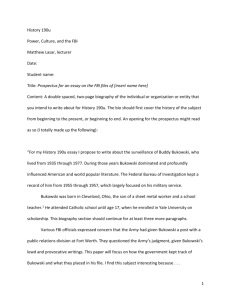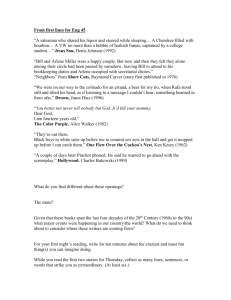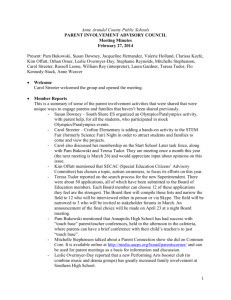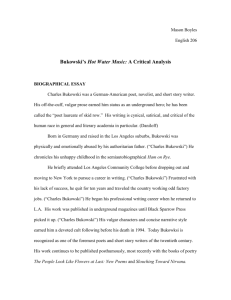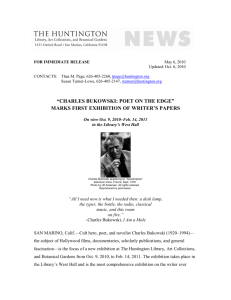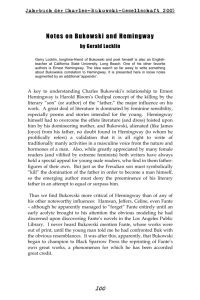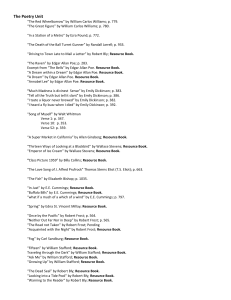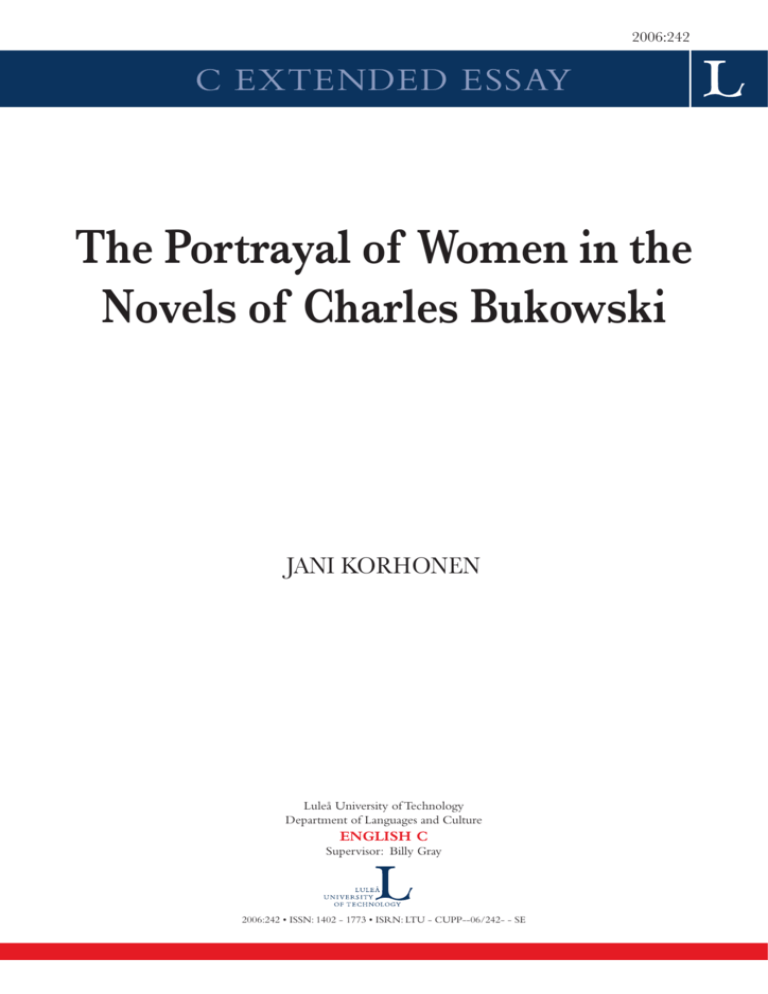
2006:242
C EXTENDED ESSAY
The Portrayal of Women in the
Novels of Charles Bukowski
JANI KORHONEN
Luleå University of Technology
Department of Languages and Culture
ENGLISH C
Supervisor: Billy Gray
2006:242 • ISSN: 1402 - 1773 • ISRN: LTU - CUPP--06/242- - SE
The Portrayal of Women in the Novels of
Charles Bukowski
JANI KORHONEN
Table of Contents
Introduction
1
1. Background
3
2. Female Hostility
9
3. Bukowski’s Language
13
4. Women as Sexual Objects
18
Conclusion
22
List of Works Cited
23
Introduction
Charles Bukowski came from severely poor conditions, he suffered unspeakable neglect as a
child, but nevertheless managed to become a worldwide celebrity. His gifts as a writer are still
viewed as being controversial. His life story is about a man who lived a rough life, but
managed to live a quite long life. He was a person that was not likely to achieve literary
success or to live a long life. Bukowski wore his heart on his sleeve in personal life as well as
in his art. Some people took offence from this while others were impressed, but all along he
remained himself, a hobo poet. Bukowski had little that he could call his own in his earlier
years and was accustomed to being evicted from apartments when he did not manage to pay
the rent. He got used to park benches and people from the lower levels of society; these were
the people that acknowledged him while others did not. He was a man who lived a stormy life
and was always in trouble with either his father, with women, landlords, the law or with
himself.1
This essay will discuss the depiction of women in the works of Bukowski. It will examine
and discuss the female portraits that Bukowski gave in his novels. The first chapter will
present background information on Bukowski, and give the reader an idea of what kind of
man he was and from what kind of conditions he came from. The second chapter will deal
with the issue of female hostility in his novels, as this is an issue that Bukowski has received a
great deal of criticism for. In the third chapter this essay will deal with the language that
Bukowski used in his novels and especially with the condescending language used in his
portrayal of female characters. The fourth and final chapter will review the subject of women
as sexual objects in his works, as they often seem to be defined on the basis of their looks and
their entire worth seem to depend on their sexual performance.
1
Aubrey Malone, The Hunchback Of East Hollywood ( Manchester, GB: Headpress, 2003) 5-7
1
Background
Charles Bukowski was born in 1920 in Andernach, Germany. His father was an American
soldier and his mother was German. Charles and his family moved to the United States when
he was three years old, and he was raised in Los Angeles and lived there for fifty years. His
first story was published in 1944 when Charles was twenty-four years old; at the age of thirtyfive he began writing poetry. Most of Bukowski´s literary works are poetry, but he also
published six novels during his lifetime. He died at the age of seventy-three, in San Pedro,
California, shortly after completing his last novel Pulp in 1994.2
According to Charles Bukowski himself, most of the material he wrote was about events
in his own life. His books are basically a portrayal of himself at the bottom of the American
society. Bukowski even put a figure on how much of his work actually is autobiographical; he
claimed that ninety-three per cent was taken directly from his own experiences and that the
last seven per cent was “improved upon”. Bukowski could be very honest in his writing but
when one looks into the facts of his life one gets the suspicion that this figure is not correct, it
is probably much more than the seven per cent that has been “improved upon”. The mix of
truth and fiction begins with the details surrounding his birth.3
Bukowski has on several occasions claimed that he was born out of wedlock, a bastard,
but this seems to be untrue. Charles parents met in Germany in the town of Andernach,
directly after World War One. His father, Henry Charles Bukowski, was a Sergeant in the US
army and his mother, Katharina Fett, was a seamstress. To start with Katharina did not show
any interest in Sgt Bukowski but Henry managed to integrate with her family and they started
dating. Katharina soon got pregnant and even though there was a delay, city records show that
they got married on the fifteenth of July in 1920. So Bukowski’s claim of being born out of
2
3
Black Sparrow Press Bio (http://www.charlesbukowski.20m.com)
Howard Sounes, Locked In The Arms Of A Crazy Life (Edinburgh, GB: Rebel Inc., 1998) 7-11
2
wedlock seems strange since he was born on the sixteenth of August the same year. The
parents named their son Heinrich Karl Bukowski after his father, later on he changed it to
Henry Charles Bukowski. The Bukowski family lived in Germany until 1923, when the
German economy collapsed. Life got so problematic after the collapse, that Charles’s father
did not have much of a choice other than to return to America. They arrived in Baltimore but
soon moved on to California, the place of birth for Henry Sr. Henry senior’s father was a man
who had been successful in construction but had started drinking and he and Henry Sr’s
mother had separated. One of Henry Sr’s brothers also had drinking problems and the other
brother was confined to a sanatorium. Henry Sr. did not get along with them or his sister of
whom he was jealous because she had managed to save a little money. The Bukowski family
moved around in Los Angeles and other than the travels that Charles undertook around in the
US in the 1940’s and early 50’s, Charles lived his entire life either in, or just outside, of Los
Angeles.4
When it comes to Charles’s childhood, it seems that he told the actual truth in many
interviews, letters to friends and his autobiographical works. He described his childhood as
joyless and frightening and wrote, “A twisted childhood has fucked me up”.5 The novel Ham
on Rye takes the reader through the childhood of “Hank Chinaski” who is closely related with
the real persona of Charles Bukowski, and early on in the novel the reader get to know one of
“Chinaski’s” earliest memories of his parents:
Two people: one larger with curly hair, a big nose, a big mouth, much eyebrow;
the larger person always seeming to be angry, often screaming; the smaller
person quiet, round of face, paler, with large eyes. I was afraid of both of
them.6
4
Ibid. 7-11
Ibid. 10
6
Charles Bukowski, Ham On Rye (New York, NY: Ecco, 1982) 9
5
3
Charles was not allowed to mix with other children in his neighbourhood since his parents
thought less of their neighbours; they thought that they were above them. But his parents did
not like him to play at all, so that he would not ruin his clothes. This led to the other kids
making fun of this “precious” new boy and they made fun of his mother’s German accent.
Bukowski’s father started beating him when he was attending elementary school, he also beat
his mother. On top of this Henry Sr. had affairs with other women and once abandoned the
family for his mistress. The Bukowski family moved to 2122 Longwood Avenue, later on
Charles called this “the house of agony, the house where I was almost done in”. The house
was nicer than their earlier homes, and the house was cleaned from top to bottom every
weekend. At first Charles did not have to help out with the routines of their new house, so this
was his first chance to play with other kids. The other boys gave him a real American
nickname, they named him Hank, and this name would stick to him for the rest of his life, as
Bukowski’s friends used it. This period of Bukowski’s life, when he got to play with other
kids, soon came to an end. His father made him cut the grass outside their house and made the
lawn mowing into a perverse game. This was normally not a big job as the lawns were quite
small, but Henry Sr. wanted the lawn mowed in an unreal manner without “one hair” sticking
up.7 This was of course an impossible task and one single blade of grass that was higher than
another was enough for the failure of his assignment. Henry Sr’s answer to young Bukowski’s
“failure” in cutting the grass was always a beating in the bathroom. These beatings were to be
a part of ordinary life for young Charles.8 In Ham on Rye the reader finds “Hank Chinaski”
assigned to this lawn mowing by his father and after the first time he has done the work the
father comes to inspect if the job is well done and gets down on his hands and knees to look:
“AH HAH!”
He leaped up and ran toward the house.
7
8
Howard Sounes, Locked In The Arms Of A Crazy Life, 7-11
Aubrey Malone, The Hunchback Of East Hollywood, 15
4
“MAMA! MAMA!”
He ran into the house.
“What is it?”
“I found a hair!”
“You did?”
“Come, I’ll show you!”
He came out of the house quickly with my mother following.
“Here! Here! I’ll show you!”
He got down on his hands and knees.
“I can see it! I can see two of them!”
My mother got down with him. I wondered if they were crazy.
“See them?” He asked her. “Two hairs. See them?”
“Yes, Daddy, I see them…”
They both got up. My mother walked into the house. My father looked at me.
“Inside…”9
Bukowski saw all the bad characteristics one can think of in his father such as cruelty,
domination, self-righteousness and so on. His mother was not any nicer to him since she never
took his part; she always supported the father, probably because she did not dare to cross him.
This fear of Henry Sr. on behalf of Katharina led to the fact that she lost her natural affection
for her son, if she ever had any. Years later Hank understood his mother’s behaviour as the
fact that she was German and that in Germany the husband’s word was the law. No matter
what reasons she had for not being supportive of her son, Hank never forgave her for not
being there for him at the time of his life when he really needed her. His mother agreed with
his father’s cruelty by watching in silence what went on and by doing this she was nearly as
9
Charles Bukowski, Ham On Rye, 69-70
5
blameworthy as his father. Hank’s mother thought that what Henry Sr. was doing was right
and therefore let it go on; she was also part of the horrors of Hank’s youth. Bukowski never
forgave his mother and she meant nothing to him in his adult life and up until the day she
died. One could say that Katharina was the source from where Hank’s exaggerated aversion
towards women sprang. He always expected females to behave in the same manner as his
mother, and if the women he met did not act as his mother he was almost surprised. Hank
used his mother’s persona as a measure when he judged other females, and she of course was
not the best female role model. However the issue of not being loved and being beaten was
not the only horrible thing Hank had to live with in his youth. When he grew up he got a
serious case of acne, doctors let him know that he suffered from acne vulgaris and that he was
the worst case they had ever seen. A long period of painful treatment followed but Charles
was at the time used to pain thanks to his father and endured this period.10
Hank attended the Los Angeles City College on a journalism course, and everything he
wrote was of course outrageous and he had to hide his works from his parents. He knew his
father would not approve of it and one day Henry Sr. found his writings and got furious and
threw his typewriter and writings through the window. When Hank returned home he
gathered his things and left home, ready for the rest of his life. 11 A similar event takes place
in Ham on Rye and “Hank Chinaski’s” mother comes to meet him on his way back home from
classes, to warn him of his father, who has found “Hank’s” short stories; “He said that he was
going to kill you! He said that no son of his could write stories like that and live under the
same roof with him!”12
10
Aubrey Malone, The Hunchback Of East Hollywood, 15-16
11
Ibid. 21
12
Charles Bukowski, Ham On Rye, 246
6
Charles Bukowski dropped out from Los Angeles City College in 1939 and moved to New
York with the ambition of becoming a writer. He failed in getting his works published and got
by on unskilled work. The fact that he could not manage to get his works published meant that
Charles gave up his writing career in 1946 and started drinking heavily for the next ten years.
The heavy drinking led to a bleeding ulcer that almost killed him. The near fatal experience
was like a sign to Charles and he began writing again. Bukowski claims his drinking has been
a useful source to his perspective in his writing; he has compared drinking to suicide but with
the possibility of returning to life and beginning all over the next day.13
13
Charles Bukowski 1920-1994, ((http://80-galenet.galegroup.com)
7
Female Hostility
Bukowski is often accused of being hostile towards women, and this might be one of the
reasons why he had some trouble in getting recognition in the beginning of his career,
especially in his home country.14 The aspect of misogyny is what Bukowski has been mostly
criticized for in his writing. One critic wrote:
Bukowski’s antics with women, his thoughts about them, are one vast and
sniggering cliché. He has nothing to tell us about them because, I’m convinced,
he knows nothing about them (e.g., “the ladies will always be the same.”) and is
determined at this point not to learn. They are a dirty joke to him, a dirty joke on
him. Inside the web of his booze-bull-and-broad exploits lurks a demon sexual
jingoist, erupting and irrupting in self-punishing concatenations; hostile,
frustrated, pugilistic-fearful of the role into which (he thinks) one is cast by fate
of genitalia. 15
This critic’s perspective represents how Bukowski’s work was viewed in his early days and
also how it continues to be viewed. Bukowski used more stereotypes in the beginning of his
career and his writing evolved during his time and became more nuanced. When you consider
Bukowki’s portrayal of women in his works it is important to know that Charles’s boyhood,
all of his adolescence and parts of his mature life took place in a time that had a poor view on
women in general. These years were the time of counter-revolution in the work of women’s
liberation, a time of strong opinions against female rights. The time when Bukowski wrote his
early novels was also the time of the second wave feminism, a period concerned with
independence and greater political action to improve women's rights. 16
14
Gerald Locklin, Charles Bukowski: A Sure Bet (Sudbury, MA: Water Row Press, 1995) 31-32
Russel Harrison, Against The American Dream: Essays On Charles Bukowski (Santa Rosa, CA: Black
Sparrow Press, 1994) 183
16
Ibid. 183-184
15
8
The main character, Hank Chinaski, who occurs in all the novels (not as the main
character in Pulp) has a negative view of women in general. Chinaski often makes up ideas
about women that contradict the real facts in order to reinforce his views. In Chinaski’s mind
women are faithless and predatory and are attracted by money and nothing else. Women leave
him and his view on the matter is at times that they leave for someone wealthier, even though
they met at times when he was broke and he has also claimed that the same woman who
leaves him for someone richer actually liked him better as a “bum” than when he was
working. So the real reasons for the breakups in his novels contradict the reasons that
Chinaski makes up in his mind. This is just a way for Chinaski to construct false ideas to
justify his views of women as being aggressive and disloyal “whores”.17
Bukowski often has a hostile way against women, but it could be argued that he is really
hostile against all people and often throughout the novels he mentions how he is most
comfortable in his own company and how he can not stand other people. While discussing the
subject with his friend Sean Penn, Bukowski himself claims that in terms of percentage, men
are worse in his novels. Sean Penn, who had a close relationship with Charles, thinks the
supposed hostility towards women is just the reaction of a broken person in a broken world.
Charles himself said that when he was fighting with a woman he felt like a “chicken shit”, and
he thought it was a legacy from his own father, that he and his father had the same blood in
their veins and that this was one of the reasons why he could treat a woman unfairly. 18 In
contrast to the way women are treated in the novels Charles seem to be really protective and
caring of the real women in his life. Charles was very protective of his daughter and on one
occasion he told one of his friends to keep his hands off her, when she was about to study at
the workplace of his friend.19
17
Ibid. 196
John Dullaghan, Born Into This (TV Documentary:2004)
19
Gerald Locklin, Charles Bukowski: A Sure Bet, 57
18
9
The most common negative reaction to the works of Bukowski is his unreasonable sexism
and the harsh and insulting terms he uses to characterize women. In his fiction there is a
constant mentioning of female infidelity. The reaction from feminists to this has often been
brutal in the few cases when they have bothered to notice his works at all. But it is not only
feminists that have had trouble with Bukowski’s engaging “war on women”; admirers of his
works have also had problems with this issue. Bukowski liked to appear as bombastically
indifferent to all feminist criticism but, in reality he was not. He is known to have replied in
lengthy letters to critics, trying to point out what his stories are actually about and that the
characters in his fiction just happened to be female and that has nothing to do with the subject
of his stories. 20
The ethics that Bukowski had concerning sexuality were formed during the Depression
and the War years, and as times changed these attitudes seemed even more old-fashioned,
patriarchal and sexist. The late 1960’s and onward, that is, the time when Bukowski achieved
popularity, was also the time of the developing Women’s Liberation Movement. Many of the
radical figures within the Women’s Liberation Movement were active in the same
underground papers as Bukowski and this of course led to an argument regarding values.
However, Bukowski was substantially supportive and preferred female artists. He was
married to a magazine editor, Barbara Frye, and later on was deeply involved with Linda King
an unmistakably pro-feminist and sculptor. In addition Bukowski encouraged and exchanged
letters with a series of female writers, artists and editors. Still, the women of - especially - his
early works are often unfaithful, hustlers and whores. This is of course a very reductive view
of women, but Bukowski’s work evolved in this area and his latter works move more towards
20
Jules Smith, “Art, Survival and So Forth”: The Poetry of Charles Bukowski (East Yorkshire, U.K: Wrecking
Ball Press, 2000) 150
10
comfortable domestic life with wife and cats and the portraits of women become more
sympathetic.21
The criticism of the works of Bukowski has not always been fair since the texts have more
complexity than some critics have seen. One of Bukowski’s early critics, Karin Huffzky,
wrote:
In his underground society he describes a purely masculine world, in which
women are hardly more than splashes of a puddle through which hardy fellows
traipse, mostly drunk, or in which they wallow. Then afterwards: wipe off &
away! Also most of the times drunk….almost everything in his head is reduced
to the magical actions: fuck, drink, fight: beating women…22
It is not true that Bukowski only writes about a masculine world, some of the female
characters in his novels actually have careers and almost all of the women have jobs,
something that his main character Chinaski does not have much of the time. Huffzky has also
argued that; “there are no women in his novels with whom a thoughtful female reader can
identify positively.” This is of course true, with a few exceptions, but this has to be looked
upon in a larger context. In the novels there are hardly any characters in general that an
intelligent reader, whether you are male or female, can identify with. Bukowski makes
women look bad in his novels but that goes for almost all of his characters no matter the sex.
The idea with his characters is not that we should identify ourselves with them; it is rather a
feeling of alienation that occurs towards the characters. Instead of thinking that Bukowski
argues in favour of sexist attitudes against women, among other things in his novels, it is
possible to argue that he is in fact questioning these attitudes and behaviours.23
21
Ibid. 150
Russel Harrison, Against The American Dream: Essays On Charles Bukowski, 214
23
Ibid. 214-215
22
11
Bukowski’s Language
In all of Bukowski’s novels women play a significant role, and the relationship between
women and men is always quite troublesome throughout the texts. Women are portrayed as
giving the main characters a lot of problems, but on the other hand women seem to be the
number one thing on the main male characters mind, it is as if the contact with women is the
most important thing in life. When Bukowski describes most of the female characters in his
novels it is often done in a harsh way. The language he uses when he is depicting women is,
on many occasions condescending. Few of the female characters in his novels are portrayed in
a positive manner, and those who are, are not the women the main characters have any kind of
close relationship with. Most of the women that are in a close relationship to the main
characters in the novels lead the same kind of life as “Henry Chinaski” who is the alter ego of
Charles Bukowski, and their relationships are often really stormy. Bukowski portrays a great
number of women who “Henry Chinaski” forms relationships with or just gets in contact with,
either in his spare time or at one of all the different jobs of “Henry Chinaski”. The choice of
language when describing all these different women has, in almost every case, a sexist or
condescending tone.
In Post Office, the first novel that Charles Bukowski published, hostility against women is
often present. “Chinaski” has been working for a while in the post office when one of his
colleagues is accused of child molestation. The accused co-worker “G.G” is not guilty of the
charges against him; he is just this old and kind man who likes to give kids candy on his
routes. One new family on his route are not familiar with “G.G” and his ways so the mother
of a little girl takes it that he is a child molester when he offers candy and speaks to the girl.
Later on when the boss of the post office tries to explain to the little girl’s mother that
everything has been a mistake, Chinaski tells us what he feels about the matter:
12
You shouldn’t suck up to that woman. She’s got a dirty mind. Half of the
mothers in America, with their precious pussies and their precious little
daughters, half the mothers in America have dirty minds. Tell her to shove it.
G.G can’t get his pecker hard, you know that.24
In this and on many other occasions throughout the novels, Bukowski shows hostility towards
women and the language is very rough and dirty. All the girl friends of Chinaski are often
referred to as “bitch” or something similar, which gives the feeling that Bukowski has serious
trouble with the opposite sex. The language is rough and unpleasant and the reader gets the
feeling that the women in the novels aim to destroy Chinaski. However, even though the
language is so tough against women this is often done in a satirical manner. Henry Chinaski
moves out to Texas with one of his girlfriends that he has in Post Office, and he is being
driven around this new town where his girlfriend has her parents. The driver is a midget and
his life story is told quite satirically:
The midget was married to a very beautiful girl. When she was in her teens she
got a coke bottle trapped in her pussy and had to go to a doctor to get it out, and,
like in all small towns, the word got around about the coke bottle, the poor girl
was shunned, and the midget was the only taker. He’d ended up with the best
piece of ass in town.25
The brutal words Bukowski uses are not the only condescending feature of how females are
depicted, as often, Bukowski emphasizes characteristics of women that come with age or a
hard life in a really negative way. You get the feeling that if women are not young and perfect
bodily, then they have lost some of their value. In one instance in the novel Factotum Henry is
in a bar and has a new acquaintance with a woman who is portrayed in this negative manner,
even though he still thinks that she has not lost all of her “good” values:
24
25
Charles Bukowski, Post Office (New York, NY: Ecco, 1971) 44
Ibid. 105
13
To my right sat a rather dark blonde, gone a bit to fat, neck and cheeks now
flabby, obviously a drunk; but there was a certain lingering beauty to her
features, and her body still looked firm and well-shaped. In fact, her legs were
long and lovely.26
The rough language often occurs when the protagonist feels jealous and when he can not
make women behave as he wants to. One instance is when Henry Chinaski’s girlfriend Lydia,
from the novel Women, goes out dancing on her own. Henry would prefer her not meeting
other men and therefore gets jealous when she does so, and his solution to this is to call her a
“whore”.27 The style of language that Bukowski uses when mentioning females is in most
cases close to this quotation, very patronising and harsh. However, this insulting and
condescending tone is not specific when it comes to women but still there is a strong negative
feeling about how he writes about them. This strong hostility against women probably has to
do with all the experiences of Bukowski's own life. From a very young age he had a really
rough time and did not get any love from his parents. All his troubles in life must have led
him to hating himself, and then it is not so far fetched that if he did not like himself it was not
so easy to be caring towards others. In the novels Chinaski often feels inadequate and this
leads to his hostility against women. Women are what he wishes he could be successful with,
but with his looks and self-esteem this is not easily done, so instead he turns out to be rough.
Bukowski’s own mother never stood up for him against his abusive father and this of course
led to a feeling of not being good enough.
Bukowski is certainly insulting in his use of language when portraying women, but there
are still many strong-minded females in his novels who will not accept to be mistreated. If the
reader compares Bukowski’s supposed insults against women with, for example, the
contemporary standards of some rap music they seem really mild in comparison. Much of
26
27
Charles Bukowski, Factotum (New York, NY: Ecco, 1975) 67
Charles Bukowski, Women (New York, NY: Ecco, 1978) 44
14
Bukowski’s work is not based on social observation but instead in American cultural
mythology, and this leads to a free play with male and female sexual stereotypes as well as
prototypes. Bukowski acquired his humour from the movies and radio shows of his youth and
he uses this humour to reinforce stereotypes and also to destroy these stereotypes. With
Bukowski it is hard to know his ideology since his works are ambiguous compared to other
authors who use manliness in literature. Bukowski’s writing is often misunderstood because
of the terminology he uses, he can be chauvinistic at times and represses female artistic
creativity and make critical associations about their sexuality. The trouble with terminology is
to understand statements that Bukowski has made such as; “Wait on the word. She’s more
faithful than any woman”. If you look at this statement correctly it says more about his
commitment to writing than about women who were crucial to him. The reason for
Bukowski’s aversion towards women, when he constantly returns to the subject of women’s
sexual disloyalty, is at least to some extent cultural and springs from American history. When
you compare writings by Bukowski with classic Country and Western music like for example
Hank Williams song Your Cheatin’ Heart one might wonder if Bukowski is any worse than
all these well accepted Country singers. The use of the term “whore” which Bukowski often
uses to characterize women seems very offensive and Bukowski’s explanation of what the
term means to him has been confusing. 28 He has given the explanation of this by saying: In a
sense, I am a romantic; I mean when I call a woman a whore, I mean, in my language, a
woman who loves one man…I also use “whore” to mean “death” which is also, in a sense,
“love” to me.29 Bukowski was rarely up for discussion about ethics; his standpoint on the
whole was that artists did not have to have any moral constraint when it comes to their
28
29
Jules Smith, “Art, Survival and So Forth”: The Poetry of Charles Bukowski, 150-153
Ibid. 153
15
activities. Charles has said that; “A man’s either an artist or a flat tire and what he does need
not answer to anything, I’d say, except the energy of his own creation”.30
30
Ibid. 153
16
Women as Sexual Objects
Most of the women in Bukowski's novels are portrayed as sexual objects, as if their worth is
defined entirely according to their looks. In his first four novels, Post office, Factotum,
Women and Ham on rye, this very harsh picture of women is a stylistic trait that is common
for all of these texts. In his fifth novel Hollywood, Bukowski is beginning to use a softer tone
in his depiction of women; in almost all the cases where Chinaski’s wife is mentioned
something positive and praiseworthy is mentioned about her. This is, of course, not what we
are used to in the earlier novels, where mostly the women are just objects and their sole
purpose seems to be to satisfy the men sexually. It seems that Hank Chinaski, already from an
early age, started to look at women in this extremely objectifying way, and this becomes very
clear when you read Ham on rye which is the one novel that takes us through the childhood of
the main character, and all of this is supposed to be linked very closely with the real life of
Charles Bukowski. Chinaski’s first attempts to have sex with women are very odd and
brutally direct on the matter, and are similar to the view of how contact between the sexes is
established in many pornographic movies. The alter ego of Bukowski, Hank Chinaski, who
we get to know throughout the first five novels, has a certain way with women. Hank
Chinaski has not had good role models in his parents and having a father like his certainly
made him different from many other kids, but the mother was not the greatest parent either.
Hanks mother never took his part in any of his beatings; she always stood on the father’s side
as shown in Ham on rye when Hank gets his first of many beatings to come; ”It wasn’t right,”
I told her.” Why didn’t you help me?” “The father,” she said, “is always right.”31 Since Hank
grew up in this way, perhaps it is not that strange that he got a kind of hateful view of not only
women, but people in general.
31
Charles Bukowski, Ham On Rye, 39
17
Hank gets to know about sex from the other school children when he is in fourth grade
and already at this stage when he is just a little boy and is not clear about what sex really is,
his approach to the subject is very harsh and strange for a young boy. When Hank gets to stay
after class for being bad he takes his chance and asks his teacher if she wants to “fuck” with
him, and this is the way in which Hank continues when he meets women.32 Women is the one
novel that deals the most with female characters. Charles had gotten to become somewhat
famous at the time when he was gathering his facts for this novel, so he was like a child trying
to make up for the lack of female interaction in his earlier days with the female groupies that
came with fame. According to Charles he felt shameful after a while and had to quit his
promiscuous life.33 Charles used his own experiences when he wrote Women but it is
important to remember that although his novels often are autobiographical to some extent they
are works of fiction and there is always a distance between the author and the persons in his
novels. Women is the novel where the distance between real life and fiction is clearer than in
the other works of Bukowski. The novel deals with sexual relationships and you get to meet
one woman after another who Hank has sex with or at least tries to get sex from.34 In the
novel Women, Bukowski wrote about his experiences with former girlfriends. Most of these
ex girlfriends did not know that they were used as material for Women and this fact caused
them some anxiety when it finally was published in 1978. Although Bukowski made a written
claim that none of the characters in the text were intended to portray any real persons, many
of the former girlfriends were offended by how they were depicted. One of his old girlfriends,
Linda King, thought that the claim that the novel was just a work of fiction was a joke to her;
she has said that; “Everybody knew everything he wrote was a real thing”.35
32
Ibid. 56
John Dullaghan, Born Into This
34
Gay Brewer, Charles Bukowski (New York, NY: Twayne Publishers, 1997) 26-27
35
Howard Sounes, Locked In The Arms Of A Crazy Life, 185
33
18
Linda at least knew what Bukowski was up to when he was writing Women but a lot of
others were not. Many of the women who did not know that they were portrayed in this novel
took offence in the way they were treated as simple objects. One of the women, Amber
O’Neil, who had been with Charles for a weekend in 1977 was not too pleased about how he
described “Tanya” who she understood, was actually a version of herself. Bukowski criticizes
“Tanya” for not knowing anything about how to give oral sex; Amber could not understand
why he wrote such things about her since she felt that they had had so many good things in
their relation. She thought that he wrote so much malign things about women in general and
she could not understand that. Amber’s explanation for why he wrote like this about women
was because he had been rejected by women on most occasions in his past and now women
were drawn to him all of a sudden and this made Bukowski suspicious towards the female
sex. Another female who was offended by Women is “Cupcakes” one of Bukowski’s past
girlfriends. Bukowski gave her the name “Tammie” in the novel Women, and “Cupcakes”
own words on the matter are; “I came across as an air-headed, cock-sucking nothing, which I
wasn’t at all”36 and she also thinks she came out as a woman without any substance. In
Women “Tammie” is depicted as loose and cheap, she is almost portrayed as a prostitute.
Bukowski also wrote in personal letters to friends that “Cupcakes” was sleeping around with a
number of different men and he thought that she was having sex for money. According to
“Cupcakes” all this is just a fantasy and just a result of Bukowski’s jealousy and paranoia.
Many of these portraits of women in the novel have led to strong feelings from the real
persons but at least some seem to have forgiven him. One such was Joanna Bull who became
the basis of the character “Mercedes” in Women, who was also portrayed very much as a
sexual object. Bukowski only wrote about her as pretty good looking but with a dull persona.
36
Ibid. 187
19
Joanna forgave Bukowski for this because, in her understanding, this was just a way for him
to write something interesting compared to writing about a healthy relationship.37
In general Bukowski treats his female characters as objects but there are instances where
you see another side of him. One example of writing about someone he really cared for, is the
character “Katherine” in Women; “I knew that some day I would write about Katherine and
that it would be hard. It was easy to write about whores, but to write about a good woman was
much more difficult.”38 However, when their relation comes to an end he draws parallels
between “Katherine” and his newly recovered car that has been impounded. He is happy when
he finds his car in good condition except for a dead battery. After taking “Katherine” to the
airport and saying goodbye to her he writes; “Katherine walked into the boarding tunnel and
was gone. I walked back to the parking lot, got in the Volks, thinking, I’ve still got this. What
the hell, I haven’t lost everything. It started.”39 “Katherine” wants to continue their
relationship and asks Hank to come visit her and to keep in touch, but Hank has decided that it
is over. This is one of several occasions where it is Hank who is the one who ends a relation
but he tries to put the blame on someone else, he sees it as she is the one who left him and that
this is the end of their relationship. In order to make it easier for himself he denies the true
facts and thinks of her just as an object that he has lost. Although Bukowski describes women
in this nearly misogynistic manner, one has to remember that the male characters also are
treated very critically. In the novel Women most of the men have the poor characteristics of
being weak, dishonest and of being unconfident sexually. The worst case of poor character is
“Chinaski”; he is often impotent from drinking, made a fool of and laughed at by young
women who clearly seem to be his superiors.40
37
Ibid. 186-187
Charles Bukowski, Women, 101
39
Ibid. 107
40
Howard Sounes, Locked In The Arms Of A Crazy Life, 187
38
20
Conclusion
Charles Bukowski is primarily remembered for his wild lifestyle, including trouble with the
law and with women. However, Bukowski always was devoted to his craft and this is often
ignored or looked upon as insignificant. Even with the life he lived, with a lot of drinking, he
always turned to his writing after all the bars had closed. He often claimed that booze and
writing saved his ass. At times women helped him with going on with life, for Bukowski that
came with a price, but he always continued to seek all the different women in his life as they
were crucial to him. Bukowski did not get dejected by the criticism he received, on the
contrary he felt as he had done something right as long as he managed to provoke anger.
Bukowski did not classify as a Beat writer, but the Beats probably made his career possible
since they widened the boundaries of taste. He was not interested in politics in the way the
Beats were, and he did not take part in the myth of life on the road; in fact he was rather bored
with his experiences of life on the road.41
In conclusion I think that Charles Bukowski was a product of a poor childhood and a
tough life. I am not sure if he was especially hostile against women, it is more likely that he
was hostile against humankind in general. It is also important to remember that most of the
characters in the novels are portrayed in a negative manner, not only the women. It is also
important to understand that the critique against the chauvinist protagonist in the texts is not
always just. Bukowski was not in my mind arguing in favour of the behaviour of his character
Hank Chinaski and of his attitudes towards women, I think he was more likely giving a harsh
picture of reality and questioning this.
41
Aubrey Malone, The Hunchback Of East Hollywood, 8-10
21
List of Works Cited
Primary Sources
Bukowski, Charles. Post Office. 1971. New York, NY: Ecco, 2002
Bukowski, Charles. Factotum. 1975. New York, NY: Ecco, 2002
Bukowski, Charles. Women. 1978. New York, NY: Ecco, 2002
Bukowski, Charles. Ham on Rye. 1982. New York, NY: Ecco, 2002
Bukowski, Charles. Hollywood. 1989. New York, NY: Ecco, 2002
Bukowski, Charles. Pulp. 1994. London, GB: Virgin Books Ltd, 2004
Secondary Sources
Brewer, Gay. Charles Bukowski. New York, NY: Twayne Publishers, 1997
Harrison, Russel. Against The American Dream: Essays On Charles Bukowski. Santa Rosa,
CA: Black Sparrow Press, 1994
Locklin, Gerald. Charles Bukowski: A Sure Bet. Sudbury, MA :Water Row Press, 1995
Malone, Aubrey. The Hunchback of East Hollywood. Manchester, GB: Headpress, 2003
Smith, Jules. “Art, Survival and So Forth”: The Poetry of Charles Bukowski. East Yorkshire,
U.K: Wrecking Ball Press, 2000
Sounes, Howard. Locked In The Arms Of A Crazy Life. Edinburgh, GB: Rebel Inc., 1998
Dullaghan, John. Born Into This. : TV Documentary, 2004
Black Sparrow Press Bio: http://www.charlesbukowski.20m.com
Charles Bukowski 1920-1994: http://80-galenet.galegroup.com
22

